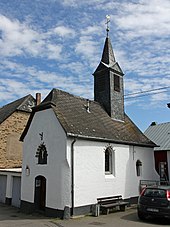Bisholder

Bisholder is a district next to the Koblenz district of Güls . It is located between orchards about one kilometer southwest of Güls in the direction of Winningen high above the Moselle valley .
history
The Bisholder estates are mentioned under different names ("Bizelre", "Byzolten", "Bysselred", "Bisholter") in medieval donation documents between 1019 and 1300. The ownership structure changes, the recipients of the donation are the Kaufungen Monastery (1019 by Emperor Heinrich II ) and the German Order Commander Koblenz (1281). It cannot be clearly proven that today's Bisholder is meant, but it is assumed by historians due to the context with other nearby locations that are given away at the same time.
In the 14th century, Bisholder was a feudal property of the County of Chiny . This is under Wenzel 1364 by the Duchy of Luxembourg acquired that after the abdication of Charles V to the 1555 War of Spanish Succession 1713/14 province of the Spanish Netherlands was. In the late phase of the Thirty Years War , around 100 Spanish soldiers were stationed here (1644). Against this background, Bisholder is sometimes called "Little Spain" in the regional vernacular and also according to its own self-image, although there has never been a civil Spanish population and still does not exist today.
Swedish troops wreaked havoc in the Thirty Years War and the plague wiped out almost the entire population. The demographic recovery in the 18th and 19th centuries was so slow that even in 1860 only four families lived in Bisholder.
After 1714 Bisholder belonged to the Austrian Netherlands . Only with the conquest of the Rhineland and the city of Koblenz in the War of the First Coalition by French revolutionary troops in 1794 the property Bisholders ends up being one of Kurtrier surrounded Habsburg enclave , which they had occupied for over 400 years. During the French period, Bisholder belonged to the canton of Rübenach within the Arrondissement de Coblence . Like Koblenz, Bisholder falls to Prussia after the Congress of Vienna and is part of the Rhine Province . The mayor's office in Winningen was established within the Koblenz district . In 1925, Bisholder had 148 inhabitants.
Since April 1, 1938, Bisholder has belonged to the municipality of Güls, which is located on the left bank of the Moselle. This fell in 1970 through incorporation into the city of Koblenz. With this step, Bisholder now also belongs to Koblenz and has become an independent district. Little can be seen of the historical core. Rather, the Bisholder of the early 21st century is a popular villa suburb of Koblenz with well-tended gardens and large terraces facing the Moselle, but difficult to access via narrow and steep streets from Güls and with little infrastructure.
Attractions

- Catholic chapel St. Antonius Eremit
The Antonius chapel (late Gothic in essence, but changed) is mentioned for the first time in a document in 1546, which shows that it belonged to the parish of today's Koblenz-Lay opposite on the right bank of the Moselle. This assignment can still be recognized from street names ( Zum Layerbach ). The Pleban of Lay received after this certificate for the reading of the fair an annual wine and fruit rate and 1 Malter grain. For the collection was end alderman responsible, who leased the surrounding Wingerte and pastures. In the single-nave chapel there is a baroque statue of Antonius of rural origin with a pig and bells ringing. The little bell - a common iconographic attribute - is also associated with a local tradition that goes back to a record from the Thirty Years' War. After that, a woman, whose husband was beaten up by Swedish soldiers, swore that if her husband got well again, she would be willing to run the band for 1 year from her own resources and to ring the "Ave" three times a day. This custom became the honorary post of “Pastor zu Bisholder”, which was passed from family to family on January 1st (handing over the keys) from year to year. Until 1981, the bell was rung by hand at 7 a.m., 12 p.m. and 7 p.m. in honor of Saint Anthony. Formally, the pastor's office still exists, although an electric bell was used in 1982. Only two masses are read each year, one on January 17th for the hermit Antonius , the second on June 13th for Anthony of Padua .
- Only a few buildings remain of the historic town center; it is a half-timbered house and quarry stone house dating from the year.
literature
- Erich Franke: Koblenz treasures. City history sketches in words and pictures . Vol. 2. Ed. By Wolfgang Schütz. Koblenz 1973.
- Alois Pickel: Bisholderer Chronik , Koblenz 2014
- Ulrike Weber (edit.): Cultural monuments in Rhineland-Palatinate. Monument topography Federal Republic of Germany. Volume 3.3: City of Koblenz. Districts. Werner, Worms 2013, ISBN 978-3-88462-345-9 .
Web links
- Historical information about Bisholder in: regionalgeschichte.net
Coordinates: 50 ° 20 ′ 3 ″ N , 7 ° 31 ′ 56 ″ E